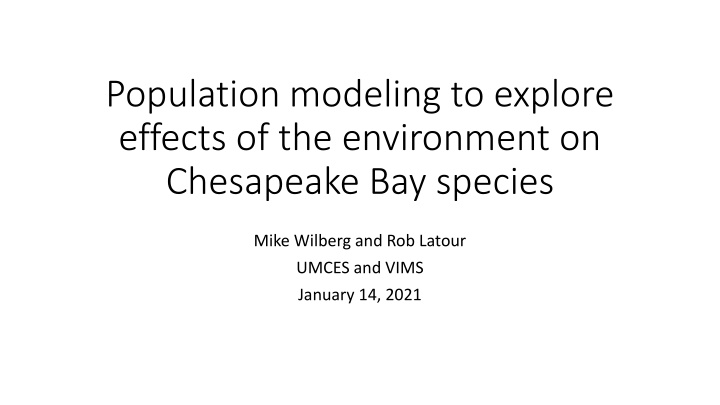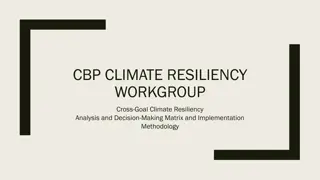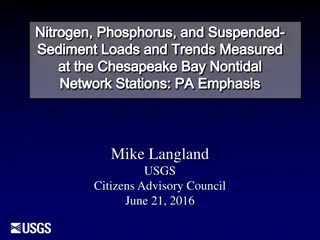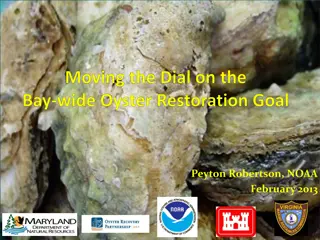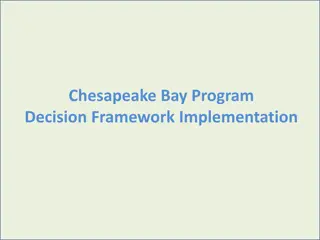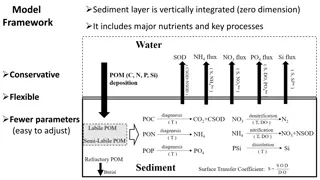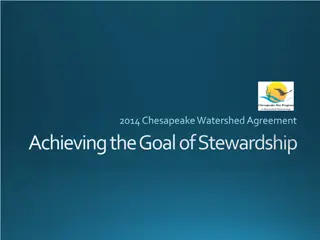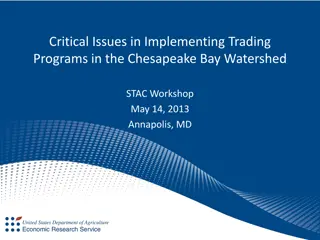Population Dynamics in Chesapeake Bay: Modeling Effects of the Environment
This project aims to develop population estimates for key species in Chesapeake Bay, exploring interactions between ecosystem changes and species dynamics. Challenges in understanding environmental effects are addressed through innovative modeling approaches utilizing data from surveys and assessment tools.
Download Presentation

Please find below an Image/Link to download the presentation.
The content on the website is provided AS IS for your information and personal use only. It may not be sold, licensed, or shared on other websites without obtaining consent from the author.If you encounter any issues during the download, it is possible that the publisher has removed the file from their server.
You are allowed to download the files provided on this website for personal or commercial use, subject to the condition that they are used lawfully. All files are the property of their respective owners.
The content on the website is provided AS IS for your information and personal use only. It may not be sold, licensed, or shared on other websites without obtaining consent from the author.
E N D
Presentation Transcript
Population modeling to explore effects of the environment on Chesapeake Bay species Mike Wilberg and Rob Latour UMCES and VIMS January 14, 2021
Interactions drive community dynamics Desire to understand effects of ecosystem changes on habitat of important species and their dynamics Top down effects (e.g., fishing, striped bass management) Bottom-up effects (e.g., nutrient reduction, land use change) Middle-out effects (e.g., menhaden management) Habitat-mediated effects (e.g., oyster restoration, sea grass restoration, hypoxia reduction) From EPA CBP
Challenges Understanding effects of the environment on populations is difficult especially so in Chesapeake Bay Lack of estimates of abundance for most species E.g., population size is extremely important for determining potential effects of changes in predators or prey Many species show extensive migrations and only use the Bay for part of the year or part of their life cycle Historically, there has been a lack of data on trends in abundance (e.g., commercial fishery landings often used as a proxy)
Why now? Data availability is better than ever, and this project would fully leverage the investments in data collection ChesMMAP and NEAMAP surveys provide information that can be used to estimate movement into and out of the Bay Assessment development tools are better than ever and can support spatial models Template Model Builder allows for estimation of complex models with random effects to allow efficient estimation of spatially structured models We can build on recent successes of spatially explicit assessments that include habitat for oysters and other recent studies of menhaden dynamics
Objectives Overarching Goal Develop population estimates for all ecologically and economically important species in the Chesapeake Bay Pilot Project Goals 1. Develop population estimates (abundance, mortality rates, and movement rates) for two key species in Chesapeake Bay (striped bass and another species), 2. Conduct studies to estimate the effects of environmental drivers on population dynamics, and 3. Make the estimates publicly available to facilitate other studies
Approach Models will be developed to estimate abundance and mortality rates over time for two Bay species using new stock assessment approaches developed specifically for this project Models would be jointly developed by the team over the next 2-3 years Two students (Samara Nehemiah (CBL), Adena Schoenfeld (VIMS)) would implement the models Modeling committees including individuals from NCBO, CB fishery management agencies, ASMFC, and others
Benefits Estimates of abundance over time for two species (initially) Estimates of how environmental factors affect population dynamics for assessed species Abundance estimates would be made publicly available to the research community (similar to ChesMMAP and NEAMAP data) Train multiple students in stock assessment and quantitative fisheries Will improve our understanding of how the CB fish community responds to habitat changes Particularly important for forecasting effects of climate change, land use change, nutrient reductions, oyster restoration, etc.
Acknowledgments Funding has been provided by the NOAA Chesapeake Bay Office We thank NCBO, VMRC, MD DNR, ASMFC, and the PRFC for their support and involvement in the project
